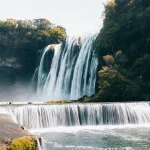If you have ever daydreamed about following in the footsteps of the Monkey King, the White Dragon Horse, Tang Monk, and their merry band of disciples, then Guizhou Province in southwest China may be your perfect travel map. Hidden among misty mountains and cascading waterfalls are filming locations that brought Journey to the West—one of China’s most beloved TV adaptations—to life. Guizhou’s natural beauty was not just a backdrop; it was the stage that made the legendary pilgrimage feel so real. And today, travelers can explore those same sites, wandering through caves, rivers, villages, and cliffs that carry both ancient myths and cinematic charm.
The Magic of Huangguoshu Waterfall
No story about Journey to the West and Guizhou would be complete without the magnificent Huangguoshu Waterfall. This roaring cascade, one of the largest waterfalls in Asia, was chosen as the filming site for the Water Curtain Cave—the Monkey King’s mischievous home. In the TV series, Sun Wukong danced through shimmering spray, leaping in and out of his watery palace. In real life, visitors can also walk behind the waterfall, exploring the naturally formed cave corridors where sunlight and water droplets weave sparkling curtains.
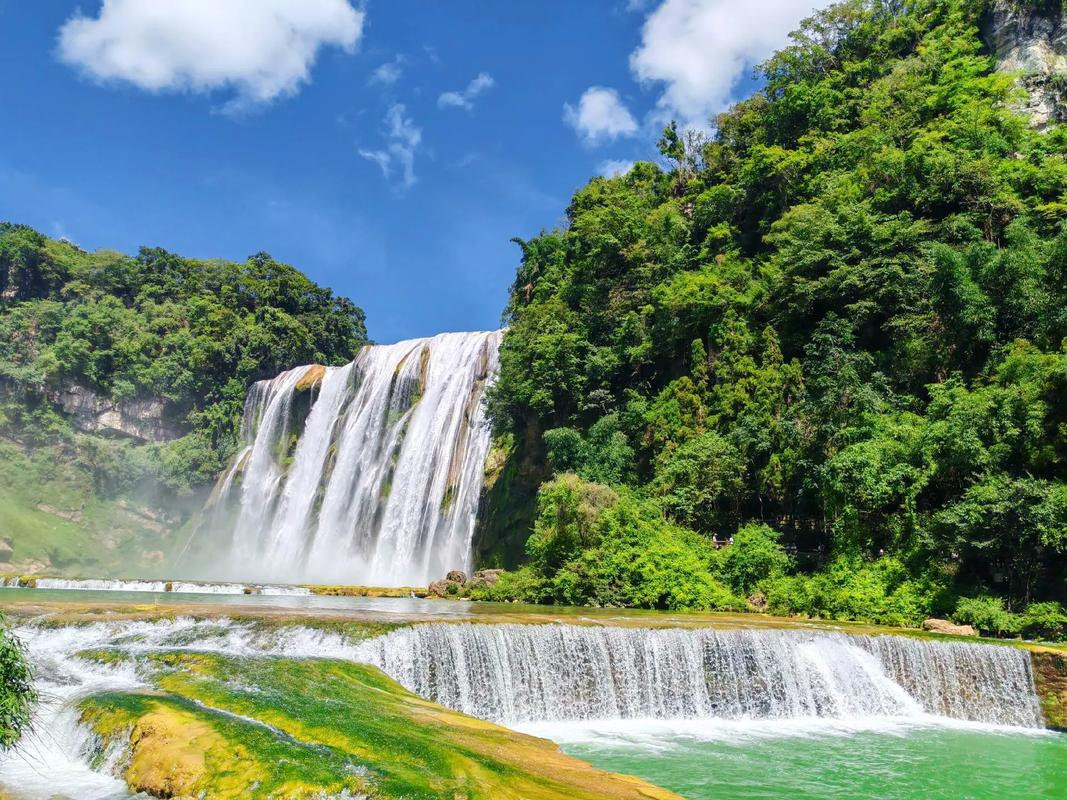
Travelers who come in summer will find the falls at their most powerful, a perfect cool escape from the heat. In autumn, the surrounding forests blush with red and gold, adding another layer of beauty. For those with a playful heart, standing in the mist may feel like stepping right into the Monkey King’s story, waiting for him to swing by on his golden cudgel. Nearby, the local specialty snack—rice tofu with spicy sauce—is a simple but delicious taste of Guizhou culture after a day of wandering.
Zhijin Cave: A Palace Beneath the Earth
Deep below Guizhou’s hills lies Zhijin Cave, an underground wonder that also appeared in the Journey to the West series. Its enormous chambers, glittering stalactites, and winding tunnels create a dreamlike setting perfect for a world of demons, deities, and celestial battles. For filmmakers, Zhijin Cave was a ready-made stage; for travelers today, it is a living gallery of geology sculpted over millions of years.
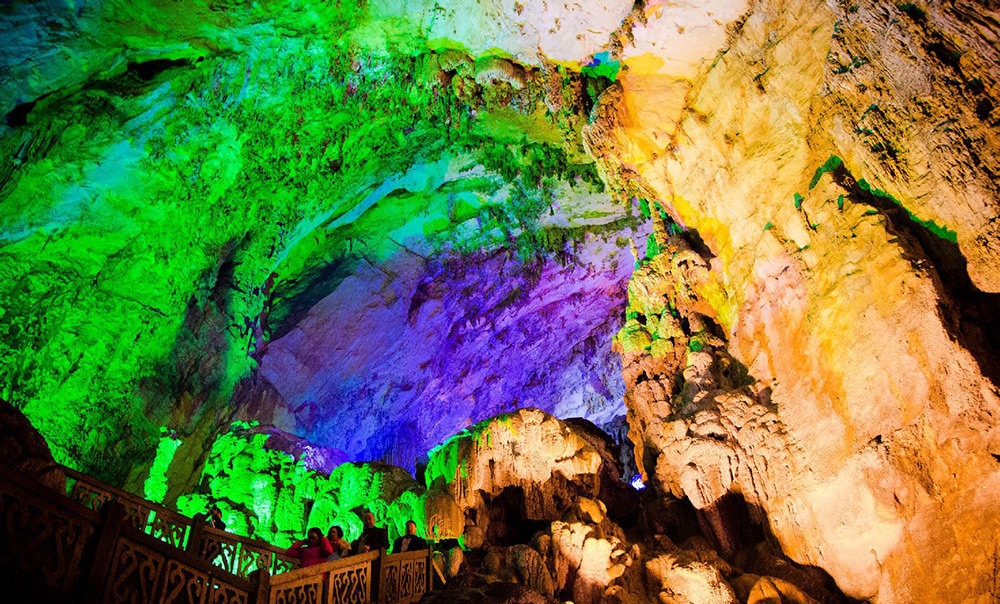
Walking through the cave feels like wandering into another dimension. Some stalactites resemble dragons, others look like castles or giant curtains. It’s easy to imagine Pigsy tripping over rocks or Wukong hiding in the shadows, waiting to surprise a foe. The cave is comfortably cool year-round, making it another excellent choice for summer visitors searching for Guizhou’s best “cool escape.”
Dragon Palace Scenic Area: A Fairytale Water World
The Dragon Palace Scenic Area in Anshun is one of Guizhou’s most enchanting spots, and it too was featured in Journey to the West. Here, emerald-green waters flow into a labyrinth of caves, forming one of the largest underground lakes in China. Taking a boat ride inside is like drifting into a fairytale, where karst formations loom above like silent guardians.

In the TV series, the Dragon Palace became the setting for episodes involving mythical underwater kingdoms and powerful river deities. Today, travelers float through the same dark caverns, lit gently by lanterns reflecting on the rippling water. Outside the caves, rolling karst hills and traditional villages add extra layers of charm. Local legends still whisper that dragons once lived in these waters, protecting the land and blessing the rains.
Fanjing Mountain: Sacred Peaks and Celestial Legends
While not always tied to a single episode, Fanjing Mountain in Guizhou echoes with the spirit of Journey to the West. Its strange mushroom-shaped rock peaks, sea of clouds, and golden summit temples seem like something pulled straight from a mythological painting. For many viewers, Fanjing Mountain embodied the “otherworldly landscapes” seen throughout the series.
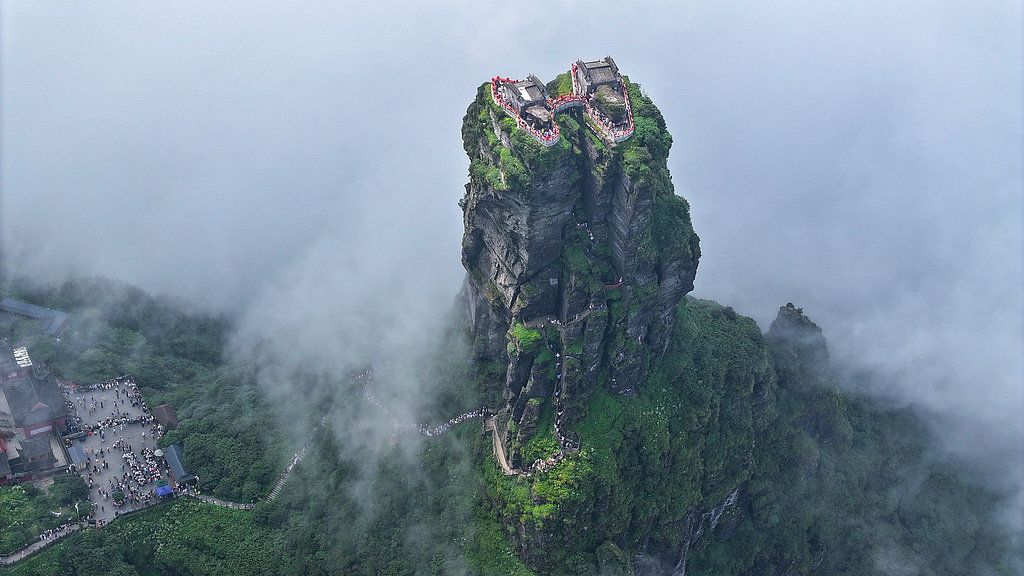
Climbing Fanjing is both a spiritual and scenic journey. Monkeys scamper across pathways, mist curls around ancient temples, and at the top, the Red Clouds Golden Summit divides into two peaks that appear to touch the heavens. It feels almost as if Tang Monk himself could be meditating here, preparing for the next leg of his long pilgrimage. For travelers, this site blends Buddhist culture with breathtaking natural scenery, making it one of Guizhou’s top attractions.
Maling River Canyon: Nature’s Dramatic Stage
Another filming site used in Journey to the West was Maling River Canyon in Xingyi, a place where waterfalls plunge down steep cliffs into a turquoise river below. The series often used this location for dramatic chases or heavenly battles, where disciples would leap across cliffs and demons would lurk in the shadows.
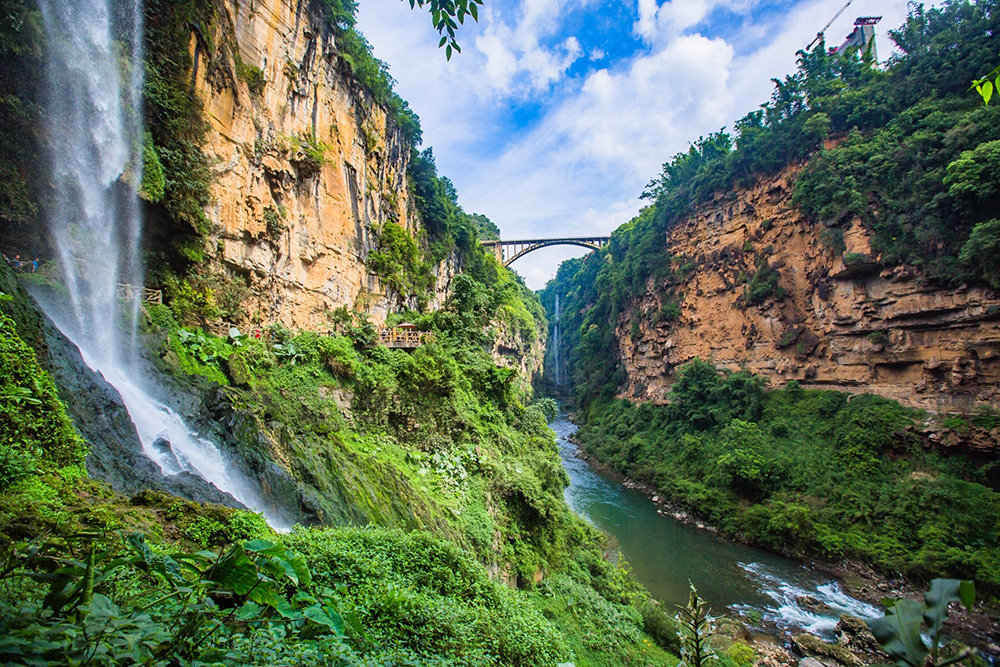
Today, visitors can walk along glass bridges and plank roads built onto the canyon walls, offering thrilling perspectives of the rushing waters. In rainy season, dozens of side waterfalls appear, creating a magical scene that feels alive with mythological energy. It’s a natural theater where Guizhou tourism truly shines, blending adventure with scenic wonder.
Beyond the Screen: Cultural Treasures of Guizhou
While the landscapes of Guizhou gave life to Journey to the West on screen, the province also offers travelers a cultural journey beyond the camera. Guizhou is home to many ethnic minority groups, including the Miao and Dong, whose colorful villages dot the mountains. Travelers can explore Xijiang Qianhu Miao Village, the largest Miao village in China, where wooden stilt houses line the hillsides and traditional festivals fill the air with songs and dances.
For food lovers, Guizhou cuisine is spicy, sour, and full of surprises. Sour fish soup, chili chicken, and sticky rice wrapped in bamboo leaves are local delicacies worth sampling after exploring filming sites. In many ways, tasting the food and meeting the locals completes the Journey to the West travel experience, adding warmth and humanity to the mythic landscapes.
Travel Tips for Your Journey to the West in Guizhou
- Best Time to Visit: Summer and autumn are the most comfortable seasons, offering lush greenery, cool caves, and waterfalls at full power.
- Transport: Guiyang, the provincial capital, is the usual entry point with good rail and air connections. From there, buses and tours connect travelers to Huangguoshu, Zhijin, and other attractions.
- Stay: From boutique hotels in Anshun to eco-lodges near Fanjing Mountain, accommodation options suit both comfort seekers and adventurous souls.
- Suggested Route: Start in Guiyang → Anshun (Huangguoshu & Dragon Palace) → Zhijin Cave → Xingyi (Maling River Canyon) → Tongren (Fanjing Mountain).
Why Guizhou is a Journey Worth Taking
Guizhou may not be the first province many think of when planning a China trip, but for fans of Journey to the West, it is a real-life film set waiting to be explored. The waterfalls, caves, rivers, and mountains that shaped the adventures of the Monkey King still shimmer with magic today. More than that, Guizhou offers a blend of nature, culture, and hospitality that makes every traveler feel like part of the story.
Whether you come for the Huangguoshu Waterfall’s Water Curtain Cave, the shimmering underground lakes of the Dragon Palace, or the cloud-wrapped temples of Fanjing Mountain, Guizhou travel is like stepping into a fairy tale where myth and reality merge. For those seeking both cinematic nostalgia and natural wonder, this province is a whimsical escape that turns summer holidays into pilgrimages of the imagination.
Contact us today to craft your dream China adventure!

